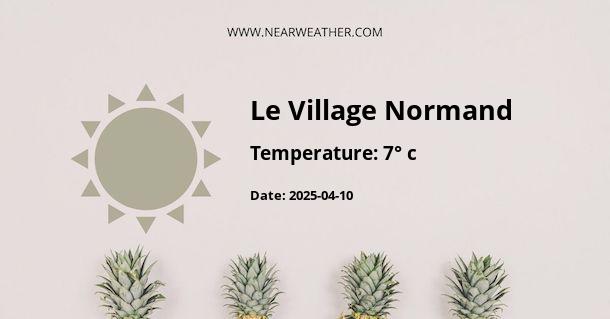Exploring the Climate and Weather of Le Village Normand, France
Le Village Normand, nestled in the picturesque region of Normandy, France, boasts a temperate maritime climate influenced by the Atlantic Ocean. This charming locale experiences distinct yet mild seasons, with weather patterns that contribute to its lush landscapes and rich agricultural tradition. Below, we delve into the climate and weather nuances of Le Village Normand, offering a detailed overview that encompasses average temperatures, precipitation, and seasonal variations that are quintessential to this region.
Seasonal Climatic Patterns
In a climate defined by the Köppen classification as 'Cfb' - Oceanic climate, Le Village Normand witnesses variability throughout the year. Here is a breakdown of the climate by the season:
Spring (March - May): As winter thaws, spring commences with cool temperatures gradually giving way to milder conditions. This period sees increased daylight and a symphony of blooming flora.
Summer (June - August): The embodiment of temperance, summers are pleasantly warm without being excessively hot, fostering an ideal environment for outdoor activities and tourism.
Autumn (September - November): A palette of orange and red hues, autumn brings cooler temperatures and a higher propensity for rainfall, a prelude to the region's quieter winter months.
Winter (December - February): Winters are generally mild with temperatures rarely plummeting below freezing, though bouts of frost are not uncommon. Snow can occur, although it's typically sparse and short-lived.
Temperature Overview
Temperature fluctuations in Le Village Normand maintain modesty throughout the year. Here is a general outline of what one can expect in terms of average high and low temperatures:
- Spring average highs: 12°C to 17°C (53.6°F to 62.6°F)
- Spring average lows: 4°C to 7°C (39.2°F to 44.6°F)
- Summer average highs: 20°C to 22°C (68°F to 71.6°F)
- Summer average lows: 11°C to 13°C (51.8°F to 55.4°F)
- Autumn average highs: 13°C to 19°C (55.4°F to 66.2°F)
- Autumn average lows: 7°C to 10°C (44.6°F to 50°F)
- Winter average highs: 6°C to 8°C (42.8°F to 46.4°F)
- Winter average lows: 1°C to 3°C (33.8°F to 37.4°F)
Precipitation Patterns
Rainfall in Le Village Normand is relatively well-distributed throughout the year, with slight peaks during the autumn months. Here is an overview of the rainfall patterns:
- Spring average rainfall: 50 mm to 70 mm (1.97 inches to 2.75 inches) per month
- Summer average rainfall: 50 mm (1.97 inches) per month
- Autumn average rainfall: 60 mm to 90 mm (2.36 inches to 3.54 inches) per month
- Winter average rainfall: 60 mm to 80 mm (2.36 inches to 3.15 inches) per month
Wind and Exposure
The proximity to the Atlantic also subjects Le Village Normand to variable wind conditions. The westerlies, prevalent throughout the year, can intensify, particularly during the autumn and winter months. This village's topography can either shield from or expose it to windier conditions, depending on the specific location.
Solar Radiation and Daylight Hours
The sun's journey in the skies of Le Village Normand has a palpable effect on daily life and mood:
Longest day: Approximately 16 hours on the Summer Solstice
Shortest day: Roughly 8 hours on the Winter Solstice
Average daylight hours:
- Spring: 12 to 15 hours of daylight
- Summer: 15 to 16 hours of daylight
- Autumn: 9 to 12 hours of daylight
- Winter: 8 to 9 hours of daylight
Microclimates and Regional Variations
While the broad-strokes climate of Le Village Normand is homogeneous, microclimates persist due to various elements such as altitude, proximity to water bodies, and urbanization. For example, coastal areas may experience milder winters and cooler summers compared to inland locations due to the moderating effect of the sea.
Climate Adaptations in Agriculture and Viticulture
The agriculture and viticulture of Le Village Normand are adapted exquisitely to the climate. Certain crops and grape varieties thrive in the temperate conditions, fostering a culinary and enological richness binded tightly to the weather and soil.
Extreme Weather Events
Although extreme weather is less common, Le Village Normand is not immune to events such as storms coming off the Atlantic, which can bring heavy rainfalls and strong winds. Such events highlight the importance of adaptive measures and preparedness in local strategies for agriculture, infrastructure, and general living.
Climate Change Considerations
Climate change projections for Normandy, including Le Village Normand, indicate potential shifts in temperature and precipitation patterns. These might involve warmer temperatures, altered seasonal distributions of rainfall, and increased frequency of extreme weather events.
Conclusion
Understanding the nuanced climate and weather patterns of Le Village Normand is essential for residents, farmers, tourists, and policy-makers alike. With its temperate climate, the village experiences a range of weather conditions that dictate the rhythms of life in this quintessentially Normand locale.
In conclusion, the climate of Le Village Normand is a tapestry woven with moderate temperatures, regular precipitation, and seasonal changes, all set against the backdrop of the Atlantic Ocean. Its weather is as much a part of its charm as its historic architecture and rich cultural history. Those seeking to immerse themselves in Le Village Normand, be it for travel, business, or research, should embrace the weather not only as a condition but as a character of this storied region.
A - Le Village Normand's Latitude is 49.666672 & Longitude is -1.733330.
A - Weather in Le Village Normand is 7° today.
A - Climate Conditions in Le Village Normand shows broken clouds today.
A - Humidity in Le Village Normand is 87% today.
A - Wind speed in Le Village Normand is 25.92 km/h, flowing at 70° wind direction. today.
